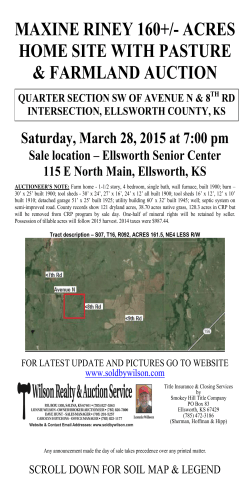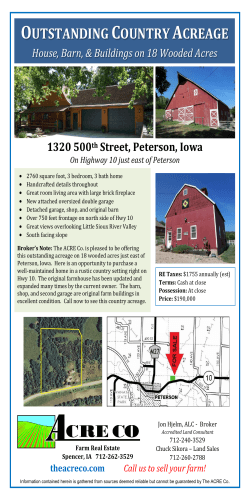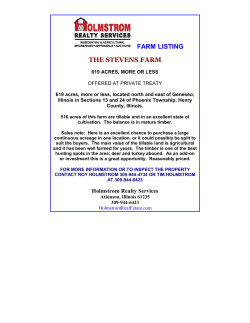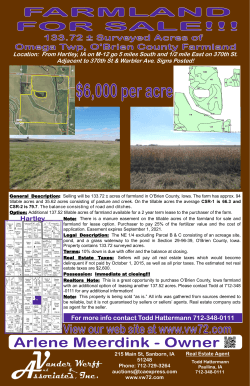
A note from the MN Agricultural Water Resource Center The current
A note from the MN Agricultural Water Resource Center The current debate over the Governor’s buffer proposal has generated a great deal of interest. While details are still unclear, it is clear that the Governor’s proposal would curtail county flexibility, likely forcing counties to increase enforcement of Minnesota DNR’s shoreland rule along rivers, streams and lakes and greatly expand the current buffer requirement along ditches. The debate is largely based on water quality and wildlife habitat. The following information is provided to help answer questions that have emerged. And a reminder—the debate should not divide Minnesotans over the goal of protecting and preserving water resources, we can all share that objective. Some frequently asked questions Is it well documented that buffers will reduce agricultural pollution? Buffer science clearly shows that where there is direct surface runoff from fields to streams, sediment and phosphorus delivery to streams and rivers will be reduced. The science does not clearly show that 50 feet is the right buffer width in all cases. Buffer effectiveness and buffer width requirements are affected by many factors, including slopes, soil types and watershed size. Buffers along constructed drainage ditches with a berm between the field and the ditch provide little benefit once the buffer extends past the crown of the berm, unless the areas is also subject to periodic high water that breaches even the berm. Buffers are very ineffective in removing nitrate nitrogen from tile water because tile lines bypass the buffer areas. Reducing nitrates in tile drainage water begins with proper nitrogen management in the field, and can be aided by practices such as routing tiles to wetlands, which are very efficient at removing nitrates. Are farmers dramatically increasing cropland acres? Data on total acreage planted to crops in MN, from the USDA’s National Agricultural Statistics Service (all in millions of acres) 1995- 19.6 1996- 20.1 1997- 20.2 1998- 20.5 1999- 20.2 2000- 20.4 2001- 19.4 2002- 20.0 2003- 20.0 2004- 19.7 2005- 19.4 2006- 19.7 2007- 19.6 2008- 19.8 2009- 19.6 2010- 19.8 2011- 19.6 2012- 20.0 2013- 19.5 2014- 19.7 These acreage figures include alfalfa and other hay. In 2014, MN farmers harvested 1.9 million acres of hay and about grazed another 2.5 million acres of pastureland, perennial crops that help reduce soil erosion. Many of these hay and pasture acres are already serving as buffers and supporting beef and dairy production, which helps create an efficient nutrient re-cycling system. Are we dramatically losing wildlife habitat due to expiring CRP contracts? CRP is a land rental program, not a land purchase program. When contracts expire, it is my experience that most farmland owners desire to put their land back into the program. This is not always possible because over time the eligibility requirements and rules have changed in an effort to better target CRP to areas providing greater environmental benefits, to increase the efficiency of program resources, such that some lands in the program during early years are no longer eligible. The current farm bill also reduced the national CRP acreage cap from 32 million acres to 24 acres, which means that acreage will likely remain at approximately current levels during the current farm bill. It is also important to note that many acres previously in CRP are now enrolled in other conservation program and continue to provide wildlife habitat. From BWSR Conservation Lands Summary- total of Federal Farm Program acres plus USFWS Easements and DNR WMAs (Wildlife Management Areas). (in million acres) 2004- 3.5 2005- 3.5 2006- 3.5 2007- 3.6 2008- 3.5 2009- 3.5 2010- 3.4 2011-3.5 2012-3.5 2013-3.4 2014-3.3 Continuous Sign-up CRP is a special subset of the CRP that is primarily focused on water quality areas, including filter and buffer strips. Data from BWSR and FSA show increasing acreage in CCRP, even while CRP has been reduced overall. (acres in thousands) 2001- 144 2002- 195 2003- 237 2004- 250 2005-262 2006-280 2007-292 2008-299 2009- 303 2010- 309 2011-335 2012- 386 2013- 393 2014- 416 2015-549 How much change has there been in urban development? According to the University of Minnesota, the state’s urban area increased from 2.2 million acres in 1990 to 3.2 million acres in 2000. Meanwhile, land in farms is declining. According to the MDA, total land in farms fell from 27.5 million acres to 26.9 million acres between 2002 and 2007. A quick math question- about 27 million acres in farms and about 22.5 million acres of crops and pasture? Why the difference? Farms provide a lot of habitat! The 4.5 million acres in question includes farmsteads, but also includes more than a million acres of CRP, along with nearly 3 million acres of wetlands, unharvested grasslands and wooded areas. Is agriculture totally unregulated? Minnesota farmers are subject to numerous regulations. Here is a partial list: Feedlots- from the MPCA website: The MPCA regulates the collection, transportation, storage, processing and disposal of animal manure and livestock processing activities, and provides assistance to counties and the livestock industry. The rules apply to all aspects of livestock production areas including the location, design, construction, operation and management of feedlots, feed storage, stormwater runoff and manure handling facilities.- read more at http://www.pca.state.mn.us/index.php/topics/feedlots/index.html Feedlot operators are also subject to local government regulations. Pesticides- from the DMA website: The Minnesota Department of Agriculture (MDA) regulates the use, application, storage, sale, handling and disposal of agricultural chemicals. This includes fertilizers and products to control weeds, insects, fungi, rodents and other pests. Pesticides must be registered with both the U.S. Environmental Protection Agency (EPA) and the state of Minnesota. The MDA Pesticide and Fertilizer Management Division (PFMD) conducts routine inspections and performs investigations about pesticide use complaints. – read more at http://www.mda.state.mn.us/chemicals/pesticides/complaints.aspx Wetlands and Drainage- from the BWSR website Since 1985, the Wetland Conservation provision of the federal farm bills (Swampbuster) requires all agricultural producers to protect the wetlands on the farms they own or operate in order to be eligible for USDA farm program benefits. The Minnesota Wetland Conservation Act (WCA) is a state law that regulates activities that result in the draining, filling, or excavating of wetlands in Minnesota, including those on agricultural land. -read more at http://bwsr.state.mn.us/wetlands/Wetlands_on_Ag_Land.pdf The Bottom Line: Water quality is a top priority of Minnesota farmers. Minnesota farmers work diligently to provide crop and livestock products on which we all depend and reduce environmental impacts. The false choice of clean water or farms is, in my view, unreasonable—society requires both, and the farming community is doing its part to contribute now and continues to strive to do even better.
© Copyright 2026









